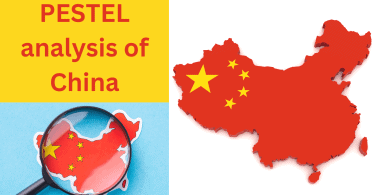Entertainment industry overview
The entertainment industry, a global force of connectivity, is undergoing a profound transformation. To investigate the main factors that impact positively or negatively the growth and the sustainability of this industry, we present our complete “Disney PESTEL analysis”.
Within this article, we discuss the global impact of the macro factors on the growth of Disney. Prepare to embark on a journey where data-driven insights guide the way as we reveal the strategies that drive change and success in the entertainment world.
Political environment
The international political environment can impact Disney’s growth and sustainability in both positive and negative ways.
Positive impacts:
Shifts to free trade policies:
Disney is a global company in many countries. Shifts to free trade policies can reduce tariffs and other trade barriers, making it easier and cheaper for Disney to distribute its products and services worldwide.
For example, the US and China could reach a trade agreement that reduces tariffs on goods imported from the US, benefiting Disney’s theme park business in China.
Government support for tourism:
Governments in some countries may offer financial support or other incentives to promote tourism. This can benefit Disney’s theme parks and resorts.
For instance, the government of India has invested in infrastructure to improve tourism, which would benefit Disney’s plans to build a theme park in India.
Negative impacts:
Trade wars and tariffs:
Trade wars and tariffs can increase the costs of Disney’s imports and exports, making its products and services more expensive for consumers.
Political instability:
Political instability in countries where Disney operates can lead to social unrest, travel disruptions, and other challenges that can hurt Disney’s business.
The government of Russia could ban Disney movies and TV shows in retaliation for Western sanctions, which would hurt Disney’s business in Russia.
Government censorship:
Governments in some countries may censor Disney’s content, limiting Disney’s reach in those markets. For instance, the European Union could impose new regulations on streaming services, which could impact Disney’s Disney+ service.
Overall, the impact of the international political environment on Disney’s growth and sustainability is uncertain. It will depend on various factors, including the specific political developments in the countries where Disney operates.
So, Disney must carefully monitor the international political environment and adapt its strategies accordingly to maintain its growth and sustainability in the coming years.
Economic environment
The international economic environment can have a significant effect on Disney’s growth in the coming years.
Unemployment:
High unemployment rates can reduce consumer spending, which could hurt Disney’s theme parks, resorts, and other businesses.
For example, during the COVID-19 pandemic, many people lost their jobs and had less money to spend on entertainment. This led to decreased attendance at Disney’s theme parks and resorts.
Inflation:
High inflation can make Disney’s products and services more expensive for consumers. This can also lead to higher costs for Disney, such as labor and materials.
For instance, if inflation rises significantly, Disney may need to increase the prices of its tickets, food, and merchandise at its theme parks. This could make it less affordable for some families to visit Disney parks.
Exchange rates:
Changes in exchange rates can influence Disney’s revenue and costs. For example, if the US dollar strengthens against other currencies, Disney will earn more revenue from its international operations.
However, it will also cost Disney more to produce and distribute its products and services in other countries.
Recession:
A recession can lead to declining consumer spending, damaging Disney’s business. For illustration, during the Great Recession of 2008-2009, Disney’s revenue and profits declined sharply. The company was forced to lay off employees and cut costs.
Disney is a large and diversified company, so it is relatively well-positioned to withstand economic downturns. However, the international economic conditions are one of the key factors that Disney will need to monitor in the coming years.
Overall, the international economic environment can have a significant impact on Disney’s growth in the coming years. A strong economy with low unemployment and inflation is generally favorable for Disney.
However, a weak economy with high unemployment and inflation can be challenging for the company. Disney will need to carefully manage its business to mitigate the risks posed by the international economic environment.
Social environment
The international social and cultural environment is also expected to have a significant effect on Disney’s growth and expansion in the coming years.
Changing customer habits:
Customers are increasingly demanding more personalized and engaging experiences. Disney is responding to this trend by investing in new technologies, such as virtual and augmented reality, to create more immersive customer experiences.
For example, at Disney World, visitors can use the My Disney Experience app to plan their day, order food and drinks, and even meet their favorite characters.
Digital natives:
Digital natives have grown up with digital technology and are comfortable using it in all aspects of their lives. Disney targets digital natives by creating content and experiences tailored to their preferences.
For example, Disney+ offers a wide variety of original and exclusive content that is appealing to digital natives. Disney is also investing in mobile gaming and other digital experiences.
Globalization:
The world is becoming increasingly interconnected, and people are more exposed to different cultures than ever before. Disney is embracing globalization by creating content relevant to a global audience.
For example, Disney+ offers a variety of international content, including movies, TV shows, and documentaries. Disney is also building new theme parks in international markets, such as China and India.
Lifestyles:
Lifestyles are changing worldwide, and Disney is adapting to these changes. For example, people increasingly live in urban areas and have less time for leisure activities.
Disney is responding to this trend by offering shorter and more affordable vacation options. For example, Disney offers one-day tickets to its theme parks and hotel packages that include transportation and dining.
Overall, Disney is well-positioned to capitalize on the trends in the international social and cultural environment. The company has a strong brand, a loyal customer base, and a deep understanding of what its customers want.
Disney is also investing in new technologies and creating new content and experiences to meet the needs of its customers in the coming years.
Technological environment
According to our investigation, the following are some of the technological factors that could impact Disney in the coming years:
Artificial intelligence (AI):
AI is already being used by Disney in various ways, such as to personalize the customer experience, develop new content, and improve operational efficiency. In the future, AI could create even more immersive and engaging experiences for Disney’s customers.
For example, AI could be used to develop virtual assistants that can help customers plan their vacations, find their favorite characters, and navigate theme parks.
Virtual reality (VR) and augmented reality (AR):
VR and AR are emerging technologies that have the potential to revolutionize the entertainment industry. Disney is already investing heavily in VR and AR, and the company is developing various new customer experiences.
For instance, Disney has developed VR experiences that allow visitors to explore the Star Wars and Marvel universes.
Streaming services:
Streaming services like Disney+ are changing how people consume entertainment. Disney is investing heavily in its streaming business, and the company is expected to continue to grow its subscriber base in the coming years.
This will give Disney a new platform to distribute its content and reach a global audience.
5G technology:
5G is a new wireless technology that offers faster speeds and lower latency than previous generations of wireless technology. 5G could enable Disney to create new and innovative customer experiences.
For example, Disney could use 5G to stream VR and AR content to mobile devices.
Blockchain:
Blockchain is a distributed ledger technology that has the potential to revolutionize the way businesses operate. Disney could use blockchain to improve its supply chain management, ticketing system, and customer loyalty program.
Also, Disney could use blockchain to create a new digital currency that could be used to purchase goods and services at its theme parks and resorts. This would make it easier for visitors to spend money at Disney and reduce the need for cash transactions.
These are just a few technological factors that could impact Disney today and in the coming years. Disney is a leader in adopting new technologies, and the company is well-positioned to capitalize on the latest trends.
Overall, the technological landscape is rapidly changing, and Disney will need to continue to invest in new technologies in order to maintain its competitive advantage.
Ecological environment
The international ecological environment is expected to have a significant impact on Disney’s growth and durability in the coming years.
Positive impacts:
Increased awareness of environmental issues:
Consumers are becoming more aware of environmental issues and are demanding more sustainable products and services. Disney is responding to this trend by investing in renewable energy, reducing waste, and using sustainable materials in its products and packaging.
For example, Disney has committed to achieving net zero greenhouse gas emissions by 2030.
Government support for sustainability:
Governments around the world are offering financial incentives and other support to businesses that adopt sustainable practices.
Disney can benefit from this government support by reducing its environmental impact and improving its efficiency. For example, Disney has received tax breaks for installing solar panels at its theme parks.
New opportunities for sustainable tourism:
Disney can develop new sustainable tourism products and services to meet the growing demand for sustainable travel. For example, Disney could offer eco-friendly tours of its theme parks and resorts, or it could develop new attractions that promote environmental awareness.
Negative impacts:
Climate change:
Climate change is already hurting Disney’s business. For example, rising sea levels threaten Disney’s theme parks in Florida and California.
Disney will need to invest in adaptation measures to protect its infrastructure and operations from the impacts of climate change.
Extreme weather events:
Extreme weather events such as hurricanes and droughts are becoming more frequent and severe due to climate change. These events can disrupt Disney’s operations and damage its theme parks and resorts.
For example, Hurricane Ian caused significant damage to Disney’s theme parks and resorts in Florida in 2022.
Water scarcity:
Water scarcity is a growing problem in many parts of the world. Disney is a major water user, and the company must find ways to reduce its water consumption to be sustainable.
For example, Disney has invested in water conservation technologies at its theme parks and resorts.
Overall, the international ecological atmosphere will have a significant impact on Disney’s growth and durability in the coming years.
Disney will need to invest in sustainability measures to reduce its environmental impact, adapt to the impacts of climate change, and meet the growing demand for sustainable tourism.
Legal environment
The international legal environment can impact Disney’s growth and expansion in the coming years in several ways.
Positive impacts:
Stronger intellectual property protection:
Disney relies heavily on its intellectual property (IP), such as its characters, stories, and trademarks. Stronger IP protection in international markets can help Disney to protect its IP from infringement and generate more revenue from its IP.
For example, the United States-Mexico-Canada Agreement (USMCA) includes many provisions that strengthen IP protection in Mexico and Canada. This could benefit Disney by making it easier to protect its IP in these markets.
Reduced trade barriers:
Governments worldwide are working to reduce trade barriers, such as tariffs and quotas. This can make it easier and cheaper for Disney to export its products and services to international markets.
For example, the Comprehensive and Progressive Agreement for Trans-Pacific Partnership (CPTPP) is a trade agreement that has reduced tariffs and other trade barriers between 11 countries. This could benefit Disney by making it easier and cheaper for the company to export its products and services to these markets.
Negative impacts:
Increased regulation:
Governments worldwide are increasing regulation of the technology sector. This could impact Disney’s streaming business, Disney+. For example, the European Union’s Digital Services Act (DSA) includes provisions regulating online platforms, such as Disney+.
The DSA could impact Disney+ by requiring the company to change its platform, such as how it collects and uses user data.
Data privacy laws:
Governments worldwide are enacting new data privacy laws. These laws could impact Disney’s ability to collect and use user data. For example, the General Data Protection Regulation (GDPR) is a data privacy law in effect in the European Union.
The GDPR gives individuals more control over their data and restricts how businesses collect and use personal data. This could impact Disney by making it more difficult for the company to collect and use user data from European residents.
Overall, the international legal climate is complex and constantly changing. Disney will need to survey the legal environment in the countries where it operates and adjust its business strategy as needed.
Disney Pestel Analysis Summary
To summarize the results of Disney Pestel analysis, we present the main opportunities and threats related to the macro environment of this company.
The table below summarizes the key opportunities and threats associated with each component of the entertainment industry PESTEL analysis, as discussed in the article.
| Components | Opportunities | Threats |
| Political Environment | – Shifts to free trade policies can reduce tariffs and trade barriers, benefiting Disney’s global distribution.
– Government support for tourism can boost Disney’s theme parks in supported countries. | – Trade wars and tariffs can increase import/export costs.
– Political instability in operating countries can disrupt business. – Government censorship can limit Disney’s content reach in some markets. |
| Economic Environment | – A strong economy with low unemployment and inflation is generally favorable for Disney.
– Disney’s diversified portfolio helps withstand economic downturns. | – High unemployment can reduce consumer spending, affecting Disney’s theme parks and resorts.
– High inflation can increase costs for Disney and make its products and services more expensive. – Recession can lead to declining consumer spending. |
| Social Environment | – Disney responds to changing customer habits by investing in new technologies, like virtual and augmented reality.
– Targeting digital natives with tailored content and digital experiences. – Embracing globalization by offering international content and building new theme parks in global markets. | – Lifestyles are changing, with people having less time for leisure activities, affecting Disney’s offerings.
– The need to cater to customers’ changing preferences and habits can be challenging. |
| Technological Environment | – Leveraging AI for personalized customer experiences and operational efficiency.
– Investing in VR and AR technologies for immersive customer experiences. – Expanding streaming services like Disney+ for content distribution. – Exploring 5G technology for innovative customer experiences. – Potential use of blockchain for supply chain management and digital currency. | – Rapidly evolving technological landscape necessitates continuous investment in new technologies to stay competitive. |
| Ecological Environment | – Increased awareness of environmental issues, allowing Disney to invest in renewable energy, reduce waste, and use sustainable materials.
– Government support for sustainability can lead to tax incentives for sustainable practices. – Developing new sustainable tourism products and services. | – Climate change, extreme weather events, and water scarcity pose risks to Disney’s operations and infrastructure.
– Adapting to the impacts of climate change and meeting the growing demand for sustainable tourism can be challenging. |
| Legal Environment | – Stronger intellectual property protection can safeguard Disney’s characters, stories, and trademarks.
– Reduced trade barriers facilitate Disney’s export of products and services. | – Increased regulation of the technology sector may impact Disney’s streaming business, Disney+.
– Data privacy laws, like GDPR, can restrict Disney’s data collection and use. |
Conclusion
In conclusion, this PESTEL analysis of Disney has allowed us to deeply examine the macro factors of this company on a global scale.
As a result, we can identify the main opportunities and threats that Disney’s top managers should consider when planning strategically for the coming years.
While the Pestel framework is a relevant and effective strategic analysis framework, it must be complemented by other analyses if you want to well understand your business’s environment.
These include Michael Porter’s Five Forces model, which allows you to analyze your industry’s competitive intensity and degree of attractiveness, and the VRIO model, which examines your company’s resources and specific skills.
Hopefully, this example of Disney PESTLE analysis has helped you better understand the use and implementation of the Pestel framework in your company, don’t forget to share this article with your friends and family!
PESTEL analysis examples 2024
To better understand the PESTEL analysis, we invite you to read our recent free examples of the Pestel framework.
PESTEL analysis of Primark
Click here to read our example of Primark’s PESTEL analysis.
PESTEL analysis of Zara
Click here to read our example of Zara’s PESTEL analysis.
PESTEL analysis of DHL
Click here to read our example of DHL’s PESTEL analysis.
PESTEL analysis of FedEx
Click here to read our example of FedEx’s PESTEL analysis.
PESTEL analysis of Chipotle
Click here to read our example of Chipotle’s PESTEL analysis.
PESTEL analysis of Brazil
Click here to read our example of Pestel’s analysis of Brazil.
PESTEL analysis of Spotify
Click here to read our example of Spotify Pestel analysis.
Chick-fil-A PESTEL Analysis
Click here to read our example of Chick-fil-A Pestel analysis.
Costco PESTEL Analysis
Click here to read our example of Costco Pestel analysis.
Microsoft PESTEL Analysis
Click here to read our example of Microsoft Pestel analysis.
Airline Industry PESTEL Analysis
Click here to read our example of the Airline industry Pestel analysis.
Walmart Pestel Analysis
Click here to read our example of Walmart Pestel analysis.
Amazon Pestel Analysis
Click here to read our example of Amazon Pestel analysis.
McDonald’s Pestel Analysis
Click here to read our example of the Netflix Pestel analysis.
Netflix Pestel Analysis
Click here to read our example of the Netflix Pestel analysis.
Apple Pestel Analysis
Click here to read our example of the Apple Pestel analysis.
Twitter Pestel Analysis
Click here to read our example of the Twitter Pestel analysis.
Facebook Pestel Analysis
Click here to read our example of the Facebook Pestel analysis.
Pestel analysis of the Social Media industry
Click here to read our example of the Pestel analysis of the Social Media industry.
Ikea Pestel Analysis
Click here to read our example of the IKEA Pestel analysis.
Tesla Pestel Analysis
Click here to read our example of the TESLA Pestel analysis.












Leave a Comment